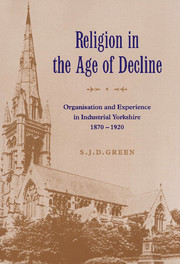Book contents
- Frontmatter
- Contents
- Acknowledgements
- List of tables
- List of abbreviations
- Introduction
- Part I Providing the means
- 1 The environment and its constraints: economic revolution, social transformation and spatial evolution
- 2 The many houses of God: churches, church building and church extension in the industrial town
- 3 The burden shared: the changing political economy of religious organisations
- Part II Drawing in the people
- Part III The trials of the religious life
- Conclusion
- Bibliography
- Index
1 - The environment and its constraints: economic revolution, social transformation and spatial evolution
from Part I - Providing the means
Published online by Cambridge University Press: 08 October 2009
- Frontmatter
- Contents
- Acknowledgements
- List of tables
- List of abbreviations
- Introduction
- Part I Providing the means
- 1 The environment and its constraints: economic revolution, social transformation and spatial evolution
- 2 The many houses of God: churches, church building and church extension in the industrial town
- 3 The burden shared: the changing political economy of religious organisations
- Part II Drawing in the people
- Part III The trials of the religious life
- Conclusion
- Bibliography
- Index
Summary
Introduction: historical geography and the social context of religious history
To the extent of their present boundaries, the County Borough of Halifax and the Metropolitan Districts of Denholme and Keighley are very nearly contiguous. But as recognisable towns, they are separated across about twelve miles of high moorland. Keighley stands at the confluence of the Rivers Aire and Worth, cradled in a stretch of land situated around North Beck and the River Worth. It is just over ten miles north-west of Bradford, and seventeen miles, in a slightly more westerly direction, from Leeds. Five miles almost due south is Denholme. Once little more than an ecclesiastical parish, then a thriving industrial village, it is now a straggling country town and a dormant commuter haven. To a visitor, perhaps the most striking aspect of the town is the fact that it stands out upon a broad shoulder of moorland which reaches up to Ogden and Thornton Moors. The centre of the town is about 900 feet above sea level, rising to 1,200 feet at Upper Bradshaw Head. Running gently downhill, about six miles further south still, lies Halifax. It is located in the Upper Calder Valley, on an extensive piece of low-lying land broken by Hebble Brook, a tributary of the River Calder. It is eight miles west of Bradford; about fifteen west-south-west from Leeds.
Geography accounts for much in this part of the world.
- Type
- Chapter
- Information
- Religion in the Age of DeclineOrganisation and Experience in Industrial Yorkshire, 1870–1920, pp. 33 - 86Publisher: Cambridge University PressPrint publication year: 1996



